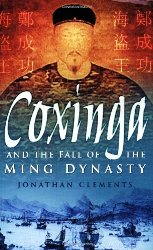The History of Maritime Piracy
Cindy Vallar, Editor & Reviewer
P.O. Box 425, Keller, TX 76244-0425
Cindy Vallar, Editor & Reviewer
P.O. Box 425, Keller, TX 76244-0425
|
|
|
|
|
|
Books for Adults - Nonfiction

![]()
![]()
![]()
![]()
![]()
In 1644, the Ming Emperor died, the general commanding the Great Wall betrayed his people, and the Manchus invaded China. They conquered Beijing, the capital of the north, but South China remained in the hands of those loyal to the Ming Dynasty. One man, Zheng Zhilong (or Nicholas Iquan as the Europeans called him), played a vital role in establishing the resistance against the invaders. At forty-one, Iquan was a merchant, soldier, former smuggler, admiral of the Chinese navy, and the leader of a confederation of pirates. His son, Coxinga, became the last loyal defender of the Ming dynasty. The Dutch and Manchus considered him a pirate. The English and Spanish called him a king. Some Chinese thought him the former, others the latter, but Coxinga thought of himself as a scholar and patriot.In the introduction, Jonathan Clements writes, “This is his story. It is also the story of his father, Nicholas Iquan, and of his deals and double-crosses with the Europeans he despised. To the superstitious, it is also the story of the goddess of the sea, and how she granted fortune on the waters to one family for forty long years. Though it ends with saints and gods, it begins with smugglers and pirates.” The author deftly sets the time and place and identifies the people and cultures in which Coxinga lived. While family and friends deserted and betrayed the Ming cause and Coxinga, he remained loyal to the centuries-long Dynasty of Brightness until his death. Eventually his enemies, the Manchus, recognized his devotion to his emperor by naming him a Paragon of Loyalty, a “hero to be emulated”.
While reading about Coxinga and the fall of the Ming Dynasty and the rise of the Qing Dynasty, I wondered why so many considered him a pirate. The son of a pirate, this account provides no evidence of piracy on his part, although he employed the Zheng fleets to further the Ming cause. Coxinga combines clarity of history with vivid imagery. It is a compelling and absorbing look into a time and place many people find exotic and unfathomable. The appendices on names, offices and appointments, and the rise of the Manchus, as well as the family trees, footnotes, source materials, and index enhance the story and make it accessible to all readers.
Book Review Copyright ©2006 Cindy Vallar
Home Pirate Articles Pirate Links Book Reviews Thistles & Pirates